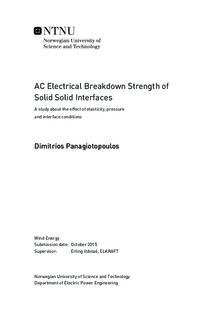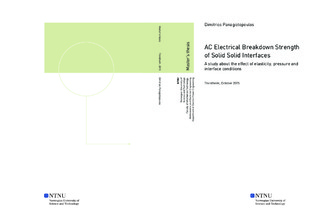| dc.description.abstract | In several electrical insulation components, such as cable connectors, joints and penetrators, various solid insulating materials are usually brought in contact, forming interfaces. The dielectric strength of these solid$|$solid interfaces is critical for the strength of the overall system. Especially in cases that the applied field has a tangential to the interface component, the solid$|$solid interface is regarded as a point of major weakness. Furthermore, these components are usually used in subsea applications and therefore the presence of water at the interface should be considered.
The primary objective of this work is to examine how the elasticity of the solid material, the applied pressure and the interface condition is influencing the 50Hz/AC breakdown strength of the interface with a tangentially applied field. First, an prediction of the effect of varying elasticity modulus on the breakdown strength is attempted through theoretical modelling, adding to existing work. Following, the assumptions are verified by experimental testing in the High Voltage Laboratory of the Norwegian University of Science and Technology (NTNU). In order to facilitate the execution of the tests, a customised setup is built in the laboratory and identical test-samples are produced and prepared. Different pressure levels are applied for each material combination (XLPE$|$XLPE, SIR$|$SIR or XLPE$|$SIR) and for each interface condition (dry, wet or oily). The test data are treated using the Weibull distribution and are compared based on the minimum, mean and $63^{rd}$ percentile value. It is seen that, generally, the minimum or the mean value is adequate to qualitatively compare the strength of different interfaces.
Through the tests, it is also seen that the softer the materials that form the interface are, the lower is the elasticity modulus and thus the higher the breakdown strength. The influence of water and insulating oil at the interface is also explored through experimental testing in the lab. Therefore, the breakdown strength of wet and lubricated (oily) interfaces is examined and compared. Through analysing and accordingly presenting the test results, it becomes evident the the wet interface behaves poorly while the lubricated facilitates higher breakdown strength values. Further, the behaviour of an interface comprised by two materials with different elasticity is investigated (hybrid interface). The hybrid interface appeared to be the least affected by water, despite the low applied pressure. | |

